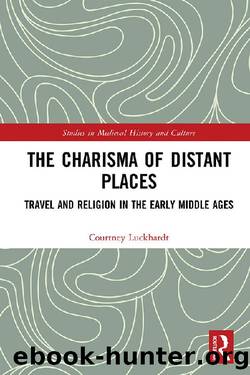The Charisma of Distant Places (Studies in Medieval History and Culture) by Courtney Luckhardt

Author:Courtney Luckhardt [Luckhardt, Courtney]
Language: eng
Format: epub
Publisher: Taylor and Francis
Published: 2019-07-14T22:00:00+00:00
4 Monastic migration and social motion
Wandering monks, often called âgyrovaguesâ in early medieval monastic rules, were considered the worst kind of monk. According to the first chapter of the Benedictine Rule (ca. 520/530), they âspend their whole lives wandering from province to province, staying as guests in different monasteries for three or four days at a time. Always roving, never stable, they are slaves to their own wills and their appetites.â1 For the privileged and settled, the religious traveler was not just a figure of power and holiness. The obverse of that power was the danger, poverty, and instability religious movement produced in those who moved, and those who encountered the unsteady lifestyle of those who tramped about from place to place. While the gyrovague was particularly disparaged in the early medieval monastic rules that sought to regulate the lives of religious professionals in Italy in the sixth century, their influence expanded out of the original Mediterranean context to Francia in the seventh, eighth, and ninth centuries.2 The gyrovague was a figure of political and religious movement. His travel was not entirely free of coercion, but neither was it entirely forced by social conditions. No hagiographers called their saintly subjects gyrovagues; monastic wandering was a concept with negative connotations since late antiquity.3
The wandering monk participated in vagabondage, in which his social motion expelled him from religious and social power structures in his place of origin and included him in new ones in his eventual destinations.4 Medieval travelers did not have an unchanging essence. This dynamic force for both individual and group movement transforms the view of medieval society as a static spatial environment. Social kinetics can help us understand medieval societies as regimes of motion, directing people and objects to expand their power through diverse forms of political, religious, and cultural movement.5 Examining itinerant monks, monastic missionaries, and visitors to monasteries demonstrates the way that religious travelers were also migrants in early medieval Europe, connected to the changes in religious ideas and practices, as well as political and social transformations. Proceeding from migrating monks, to their new monastic settlements, to contestations of monastic movement, the liminality of the migrant and the border involves space, but need not be reduced to space. The motion and circulation of religious migrants was geographical, as well as social and economic. Both geography and the social motion of religious travelers demonstrates that the early medieval world was a dynamic place.
Download
This site does not store any files on its server. We only index and link to content provided by other sites. Please contact the content providers to delete copyright contents if any and email us, we'll remove relevant links or contents immediately.
The 5 Love Languages: The Secret to Love That Lasts by Gary Chapman(9298)
The Space Between by Michelle L. Teichman(6587)
Assassin’s Fate by Robin Hobb(5867)
Wiseguy by Nicholas Pileggi(5333)
Everything Happens for a Reason by Kate Bowler(4485)
Gerald's Game by Stephen King(4386)
Pillow Thoughts by Courtney Peppernell(4032)
A Simplified Life by Emily Ley(3975)
The Power of Positive Thinking by Norman Vincent Peale(3871)
Resisting Happiness by Matthew Kelly(3203)
Girl, Wash Your Face by Rachel Hollis(3130)
Harry Potter and the Prisoner of Azkaban (Book 3) by J. K. Rowling(3125)
Being Aware of Being Aware by Rupert Spira(3092)
Real Sex by Lauren F. Winner(2875)
The Code Book by Simon Singh(2873)
More Language of Letting Go: 366 New Daily Meditations by Melody Beattie(2860)
Name Book, The: Over 10,000 Names--Their Meanings, Origins, and Spiritual Significance by Astoria Dorothy(2849)
The Holy Spirit by Billy Graham(2783)
The Secret Power of Speaking God's Word by Joyce Meyer(2762)
